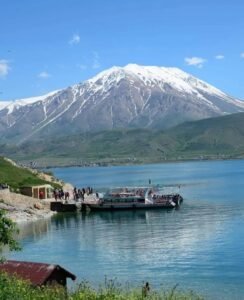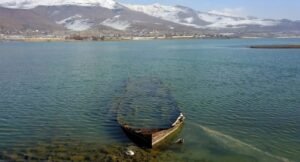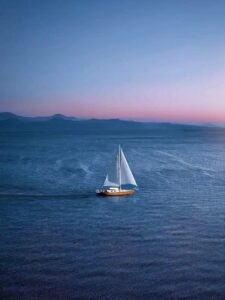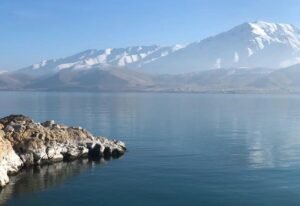Description
Lake Van (Van Gölü) – The Enchanting Jewel of Eastern Turkey
Nestled amidst the picturesque landscapes of eastern Turkey, Lake Van (Van Gölü) is the largest lake in the country and one of the most breathtaking natural wonders in the region. Straddling the provinces of Van and Bitlis, this vast, saline soda lake captivates visitors with its deep blue waters, rich historical heritage, and surrounding mountainous scenery.
A Natural Wonder
Geological Formation and Unique Properties
Lake Van, a relic of volcanic activity, was formed thousands of years ago when a lava flow from Mount Nemrut blocked its natural outlet. Covering approximately 3,755 square kilometers (1,450 square miles) and with a depth reaching 450 meters (1,480 feet), it is the largest soda lake in the world. Due to its high alkalinity and salinity, it hosts a unique ecosystem where only specific microorganisms and the endemic pearl mullet (inci kefali) thrive.
The lake’s water is so rich in minerals that it has natural cleansing properties, allowing people to wash clothes without the need for detergent. This distinct feature adds to its mystical appeal and cultural significance among locals.
Historical and Cultural Significance
Urartian Legacy
The history of Lake Van is as deep as its waters. The region was once the heart of the ancient Urartu Kingdom (9th-6th century BCE), which left behind remarkable fortresses and inscriptions. One of the most famous remnants of this era is Van Castle (Van Kalesi), perched on a rocky outcrop overlooking the lake. The castle houses the inscriptions of Xerxes I, a Persian ruler, and offers a stunning panoramic view of the lake.
Armenian Heritage and Akdamar Island
One of the most iconic landmarks in Lake Van is Akdamar Island, home to the stunning Akdamar Church (Church of the Holy Cross). Built in the 10th century by the Armenian King Gagik I of the Kingdom of Vaspurakan, the church boasts intricate stone reliefs depicting biblical scenes. Today, it serves as a symbol of Armenian architectural heritage and attracts both history enthusiasts and spiritual travelers. The island itself is a peaceful retreat, with almond trees blooming spectacularly in spring.
Bitlis and Ahlat: The Hidden Gems
On the western shores of Lake Van lies the historic town of Ahlat, part of Bitlis Province. Ahlat is renowned for its Seljuk-era cemeteries, featuring thousands of intricately carved tombstones from the 12th to 15th centuries. These monuments stand as a testament to the artistic and cultural achievements of the Seljuk and Ottoman periods. Additionally, Bitlis is home to charming old stone houses, mosques, and bridges that offer a glimpse into Turkey’s medieval past.
Tourism and Activities
Boat Tours and Island Exploration
Visitors can embark on boat tours across Lake Van, exploring its four main islands: Akdamar, Adır, Çarpanak, and Kuş. Each island has its own historical and natural attractions, making island-hopping a memorable experience.
- Akdamar Island – Famous for its ancient Armenian church.
- Adır Island – Lesser-known but rich in Armenian monastery ruins.
- Çarpanak Island – Offers serene landscapes and birdwatching opportunities.
- Kuş Island – An important nesting site for migratory birds.
Swimming and Water Activities
Despite its high salinity, Lake Van’s water is swimmable and offers a refreshing experience, especially during the hot summer months. The Reşadiye and Van public beaches are popular spots for locals and tourists alike. Kayaking, sailing, and fishing are also favored activities, allowing visitors to engage with the lake’s pristine beauty.
Mountaineering and Hiking
The dramatic landscapes surrounding Lake Van make it a paradise for hikers and adventure seekers. Two prominent volcanic peaks, Mount Süphan (4,058 meters) and Mount Nemrut (2,948 meters), offer excellent trekking opportunities.
- Mount Nemrut (Bitlis side) is particularly famous for its crater lake, an awe-inspiring sight within an already stunning natural setting.
- Mount Süphan, the third-highest peak in Turkey, presents a challenging yet rewarding climb with spectacular views over Lake Van.
Cultural Festivals and Local Cuisine
Throughout the year, various festivals and cultural events celebrate the traditions of the Van and Bitlis regions. The Van Cat Festival showcases the unique Van cats, a rare breed known for their heterochromatic eyes (one blue, one amber). Meanwhile, local markets brim with delicacies such as:
- Van Breakfast (Van Kahvaltısı) – A famous spread featuring fresh cheeses, honey, herbed butter, and the local murtuğa dish.
- Inci Kefali (Pearl Mullet) – The only fish species that survives in the lake’s alkaline waters, offering a distinct taste.
- Bitlis Büryan Kebab – A slow-cooked lamb dish, unique to the region.
How to Get to Lake Van
Lake Van is well-connected by air, road, and rail:
- By Air: The nearest airport is Van Ferit Melen Airport (VAN), with flights from major Turkish cities like Istanbul and Ankara.
- By Train: The Van-Tatvan ferry allows train travelers to cross the lake as part of the famous Trans-Asia Express route between Turkey and Iran.
- By Road: Buses and minibuses run regularly from Erzurum, Diyarbakır, and other nearby provinces.
Best Time to Visit
The best seasons to visit Lake Van are spring (April-June) and autumn (September-November) when temperatures are mild, and nature is at its most vibrant. Winter (December-February) offers stunning snowy landscapes, while summer (July-August) is ideal for water activities.
Conclusion
Lake Van is more than just a natural wonder; it is a cultural and historical treasure trove waiting to be explored. From ancient fortresses to breathtaking islands, from hiking majestic mountains to enjoying the world-renowned Van breakfast, every visitor finds something magical in this unique corner of Turkey. Whether you are a history buff, a nature lover, or an adventure seeker, Lake Van promises an unforgettable experience that will leave you in awe of its timeless beauty.
Location
-
Van Gölü






